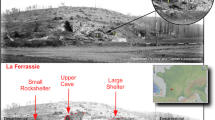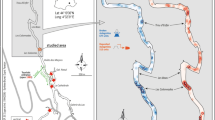Abstract
Excavations at the cave site of Xianrendong (Jiangxi Province, China) recovered the earliest known pottery (20/19,000 cal bp) in the world from a typical South China Upper Paleolithic chopper–chopping tool assemblage together with bone, antler, and shell tools. Here, we present the results of micromorphological and preliminary FTIR analysis of the deposits looking at high-resolution evidence of site formation processes, stratigraphic integrity, and spatial use of the site. The excavations in the cave can be divided into two areas, east and west. We demonstrate that the contexts of the micromorphological samples from both areas show negligible disturbances within the deposits, thus supporting the stratigraphic integrity of the radiocarbon samples used to date the pottery and site sequence. We also find differences in the formation processes between the east and west areas, including evidence of anthropogenic activities such as usage of hearths and dumping areas and differing geogenic inputs during the depositional history of each area. This study, the first of its kind for a Chinese Upper Paleolithic cave site, demonstrates the advantages of the systematic use of geoarchaeological methods (micromorphology and FTIR) for reconstructing human activities and site use and their environmental contexts.


















Similar content being viewed by others
References
Beijing and Jiangxi (2014) School of Archaeology and Museology Peking University, Jiangxi Province Institute of Cultural Relics and Archaeology (eds). Xianrendong and Diaotonghuang. Cultural Relics Press, Beijing (in Chinese)
Berna F, Goldberg P (2007) Assessing Paleolithic pyrotechnology and associated hominin behavior in Israel. Isr J Earth Sci 56:107–121
Berna F, Behar A, Shahack-Gross R, Berg J, Boaretto E, Gilboa A, Sharon I, Shalev S, Shilstein S, Yahalom-Mack N, Zorn JR, Weiner S (2007) Sediments exposed to high temperatures: reconstructing pyrotechnological processes in late bronze and Iron Age strata at Tel Dor (Israel). J Archaeol Sci 34:358–373
Boaretto E, Wu X, Yuan J, Bar-Yosef O, Chu V, Pan Y, Liu K, Cohen D, Jiao T, Li S, Gu H, Goldberg P, Weiner S (2009) Radiocarbon dating of charcoal and bone collagen associated with early pottery at Yuchanyan cave, Hunan Province, China. Proc Natl Acad Sci U S A 106(24):9595–9600
Brammer H (1971) Coatings in seasonally flooded soils. Geoderma 6:5–16
Cohen DJ (2013) The advent and spread of early pottery in East Asia: new dates and new considerations for the world’s earliest ceramic vessels. J Austronesian Stud 4:55–92
Cohen DJ, Bar-Yosef O, Wu X, Patania I, Goldberg P (2017) The emergence of pottery in China: recent dating of two early pottery cave sites in South China. Quat Int 441(Part B):36–48
Courty MA, Goldberg P, Macphail R (1989) Soils and micromorphology in archaeology. In: Cambridge manuals in archaeology. Cambridge University Press, Cambridge
Day MJ, Tang T (2004) Tower karst. Encycl Caves Karst Sci:734–736
Durand N, Monger CH, Canti MG (2010) Calcium carbonate features. In: Stoops G, Marcellino V, Mees F (eds) Interpretation of micromorphological features of soils and regoliths. Elsevier, Amsterdam, pp 149–194
Ford DC, Williams PW (1989) Karst geomorphology and hydrology. Unwin Hyman, London
Goldberg P, Aldeias V (2018) Why does (archaeological) micromorphology have such little traction in (geo) archaeology? Archaeol Anthropol Sci 10:269–278
Holland HD, Kirsipu TV, Huebner JS, Oxburgh UM (1964) On some aspects of the chemical evolution of cave waters. J Geol 72:36–67
Huang CC, Pang J, Zha X, Zhou Y, Su H, Zhang Y, Wang H, Gu H (2012) Holocene palaeoflood events recorded by slackwater deposits along the lower Jinghe River valley, middle Yellow River basin, China. J Quat Sci 27:485–493
Huang W, Deng CB, Day MJ (2013) Differentiating tower karst (fenglin) and cockpit karst (fengcong) using DEM contour, slope, and centroid. Environ Earth Sci 72:407–416
Hughes PD, Gibbard PL (2015) A stratigraphical basis for the last glacial maximum (LGM). Quat Int 383:174–185
Hughes PD, Gibbard PL, Ehlers J (2013) Timing of glaciation during the last glacial cycle: evaluating the concept of a global “Last Glacial Maximum” (LGM). Earth Sci Rev 125:171–198
Jiangxi Provincial Committee on Cultural Relics Management (1963) Report on the test excavation of Xianrendong cave, Dayuan, Wannian, Jiangxi. Kaogu xuebao 1963(1):1–16 (in Chinese)
Jiangxi Provincial Museum (1976) Second report on the excavation of Xianrendong cave, Dayuan, Wannian, Jiangxi. Wenwu 1976(12):23–35 (in Chinese)
Kuzmin YV (2013) Origin of Old World pottery as viewed from the early 2010s: when, where and why? World Archaeol 45:539–556
Kuzmin YV (2015) The origins of pottery in East Asia: updated analysis (the 2015 state-of-the-art). Doc PraehistI XLI:1–12
Lindbo DL, Stolt MH, Vepraskas MJ (2010) Redoximorphic features. In: Stoops G, Marcellino V, Mees F (eds) Interpretation of micromorphological features of soils and regoliths. Elsevier B.V., New York, pp 129–147
Liu J, Wu X, Li Z, Zhang M (1997) The last glacial stratigraphic sequence, depositional environment and climatic fluctuations from the Aeolian sand dune in Hongguang, Pengze, Jiangxi (China). Quat Sci Rev 16:535–546
MacNeish RS, Libby JG (1995) Origins of rice agriculture, the preliminary report of the Sino-American Jiangxi (PRC) Origin of Rice Project SAJOR. Andover Foundation, Andover
MacNeish RS (1999). A Paleolithiceneolithic sequence from South China Jiangxi Province, PRC. In: Omoto, K. (Ed.), Interdisciplinary Perspectives on the Origins of the Japanese. International Research Center for Japanese Studies, Kyoto
MacNeish RS, Libby JG (1999) A Paleolithic–Neolithic sequence from South China Jiangxi Province, PRC. In: Omoto K (ed) Interdisciplinary perspectives on the origins of the Japanese. International Research Center for Japanese Studies, Kyoto, pp 233–255
MacNeish RS, Cunnar G, Zhao Z, Libby J (1998) Second annual review of the Sino-American Jiangxi (PRC) Origin of Rice Project SAJOR. Andover Foundation, Andover
Macphail RI, Goldberg P (2010) Archaeological materials. In: Stoops G, Marcellino V, Mees F (eds) Interpretation of micromorphological features of soils and regoliths, pp 597–630
Schiegl S, Goldberg P, Pfretzschner H, Conard NJ (2003) Paleolithic burnt bone horizons from the Swabian Jura: distinguishing between in situ fireplaces and dumping areas. Geoarchaeology 18:541–565
Simms SR, Berna F, Bey GJ (2013) A prehispanic Maya pit oven? Microanalysis of fired clay balls from the Puuc region, Yucatán, Mexico. J Archaeol Sci 40:1144–1157
Stoops G (2003) Guidelines for analysis and description of soil and regolith thin sections. Soil Science Society of America Inc., Madison
Stoops G, Marcellino V, Mees F (eds) (2010) Interpretation of micromorphological features and regoliths. Elsevier B.V., Amsterdam
Van Vliet-Lanoë B (1987) Dynamique périglaciaire actuelle et passée : apport de l’étude micromorphologique et de l’expérimentation. Buletin de 'AFEQ 24:113–132
Van Vliet-Lanoë B, Cotard J, Pissart A (1984) Structures caused by repeated freezing and thawing in various loamy sediments: a comparison of active, fossil and experimental data. Earth Surf Process Landf 9:553–565
Vepraskas MJ, Wilding LP, Drees LR (1994) Aquic conditions for soil taxonomy: concepts, soil morphology and micromorphology. In: Ringrose-Voase A, Humphreys G (eds) Soil micromorphology. Elsevier, Amsterdam, pp 117–131
Waltham T (2008) Fengcong, fenglin, cone karst and tower karst. Cave Karst Sci 35:77–88
Wang W-M, Ding J-L, Shu J-W, Chen W (2010) Exploration of early rice farming in China. Quat Int 227:22–28
White WB (2007) Cave sediments and paleoclimate. J Cave Karst Stud 69:76–93
Wu X, Zhang C, Goldberg P, Cohen DJ, Yan P, Arpin T, Bar-Yosef O (2012) Early pottery at 20,000 years ago in Xianrendong cave, China. Science 336:1696–1700
Zhang S (1989) Paleokarst of China. In: Bosak P, Ford D, Glaszek J, Horacek I (eds) Developments in earth surface processes 1: Paleokarst, a systematic and regional review. Elsevier, New York, pp 297–311
Zhang C (1999) The excavations at Xianrendong and Diaotonghuan, Jiangxi. BIPPA 18:97–100
Zhang C (2002) The discovery of early pottery in China. Doc Praehist XXIX:29–35
Zhu XW, Waltham T (2004) Tiankeng: definition and description. Speleogenes Evol Karst Aquifer 4(1):1–8
Zhu X, Zhu D, Zhang Y, Lynch E (2013) Tower karst and cone karst. In: Shroder JF (ed) Treatise on geomorphology. Academic, San Diego, pp 237–340
Acknowledgments
Funding for this project was provided through grants from the National Science Foundation (USA) (no. 0917739 and no. 0551927) and the American School for Prehistoric Research (Peabody Museum, Harvard University). Logistical support was provided by the Jiangxi Provincial Government, Wannian County Government, and Jiangxi Provincial Museum, and we extend our gratitude for their gracious and enthusiastic help.
Author information
Authors and Affiliations
Corresponding author
Additional information
Publisher’s note
Springer Nature remains neutral with regard to jurisdictional claims in published maps and institutional affiliations.
Electronic supplementary material
ESM 1
(DOCX 312 kb)
Rights and permissions
About this article
Cite this article
Patania, I., Goldberg, P., Cohen, D.J. et al. Micromorphological analysis of the deposits at the early pottery Xianrendong cave site, China: formation processes and site use in the Late Pleistocene. Archaeol Anthropol Sci 11, 4229–4249 (2019). https://doi.org/10.1007/s12520-019-00788-6
Received:
Accepted:
Published:
Issue Date:
DOI: https://doi.org/10.1007/s12520-019-00788-6




